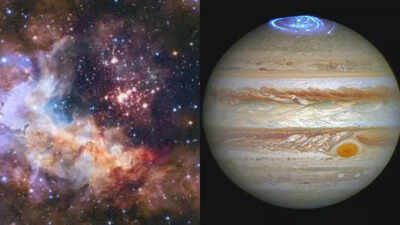- News
- Science News
- NASA reveals 6 stunning cosmic views featuring glowing nebulae and distant galaxies
NASA reveals 6 stunning cosmic views featuring glowing nebulae and distant galaxies
NASA has released new cosmic images captured by the Hubble and James Webb telescopes. The images feature stellar phenomena like Westerlund 2, Jupiter's auroras, the Lost Galaxy, the Black Eye Galaxy, NGC 1850, and CW Leonis. These photographs provide insights into the universe's beauty and mysteries, including star formation and black holes.
The universe is a grand work of art, and NASA has once again provided a stunning collection of cosmic marvels. With glowing nebulae that are filled with color and distant galaxies that seem like celestial whirlpools, these most recent images provide a dazzling view into the universe. Taken by high-powered telescopes such as Hubble and James Webb, they document the wonder and enigma of the cosmos in exquisite detail. Whether star nurseries, black holes, or previously unseen galaxy formations, these photos serve as a reminder of just how amazing our universe really is. NASA's recent photographs are a breathtaking reminder of the beauty beyond earth.
6 mesmerizing cosmic views revealed by NASA
Westerlund 2
Westerlund 2 is a young and compact star cluster situated about 20,000 light-years away in the constellation Carina. Thought to be between one and two million years old, it lies within the star-forming region known as Gum 29. This cluster is home to some of the galaxy’s hottest, brightest, and most massive stars, including early-type O stars and Wolf-Rayet stars. These giants release intense ultraviolet radiation and strong stellar winds, shaping the surrounding gas and dust into intricate formations. In 2015, the Hubble Space Telescope captured a breathtaking image of Westerlund 2, showcasing its dense stars and stunning nebula.

Jupiter's auroras
Jupiter's auroras are spectacular light displays that ring its polar caps, formed by the interaction between its magnetic field and charged particles. In contrast to Earth's transient auroras, Jupiter's are persistent, fueled primarily by particles from its volcanically active moon, Io. These particles ride along the planet's strong magnetic field lines, crashing into atmospheric gases to create dramatic ultraviolet emissions. Hubble Space Telescope observations have imaged these dynamic auroras, which show their complexity and power. Understanding them gives scientists useful information about Jupiter's magnetosphere and the role its moons have in creating these magnificent space displays.

Lost Galaxy
NGC 4535, or the "Lost Galaxy," is a barred spiral galaxy approximately 50 million light-years distant in the Virgo constellation. It is part of the immense Virgo Cluster, which harbors nearly 2,000 galaxies. The "Lost Galaxy" moniker was assigned by amateur astronomer Leland S. Copeland in the 1950s, prompted by its foggy appearance through small telescopes. Hubble Space Telescope observations unveil its dramatic spiral arms and shining core. Its core emits a gentle orange color, set against the blue spiral arms where stars are born. Observations of NGC 4535 inform astronomers about the development of spiral galaxies in tight clusters.

Black Eye Galaxy
NGC 4826, the "Black Eye Galaxy" or "Evil Eye Galaxy," is a striking spiral galaxy situated about 17 million light-years away in the constellation Coma Berenices. It owes its spooky name to a broad dark dust lane that covers up part of its bright central core, giving it the appearance of a cosmic "black eye."
What is so interesting about NGC 4826 is its rare counter-rotating gas systems—where the galaxy's inner part spins one way, the outer gas spins the other. That implies a previous merger with another galaxy, so it is an interesting target for astronomers examining galactic evolution. Hubble Space Telescope images show us its intricate structure, showcasing the interaction of dust, gas, and star formation.

NGC 1850
NGC 1850 is an interesting double star cluster located approximately 160,000 light-years from the Milky Way in the Large Magellanic Cloud, a satellite galaxy. The young cluster, which is around 100 million years old, holds several thousand stars and possesses a clear structure.
In 2021, scientists at the European Southern Observatory's Very Large Telescope (VLT) found a stellar-mass black hole in NGC 1850. At about 11 times the Sun's mass, it was found by its effect on a star close to it. This finding, the first of its kind in a young star cluster outside our galaxy, sheds important light on how black holes are born and evolve in crowded stellar settings.

CW Leonis
CW Leonis, or IRC+10216, is a carbon-rich red giant star located about 400 light-years from Earth in the constellation Leo. Enveloped in a dense shell of gas and dust, this star is well into its end stages, ejecting its outer layers. Infrared observations, especially by the Hubble Space Telescope, have revealed complex structures in this envelope, such as bright rays of light that have fluctuated in brightness over the past 15 years. These observations are important in understanding mass loss and dust formation processes in older stars.

Also Read:6 black hole pictures from NASA’s Hubble Space Telescope

About the Author
TOI Science DeskEnd of Article
FOLLOW US ON SOCIAL MEDIA

